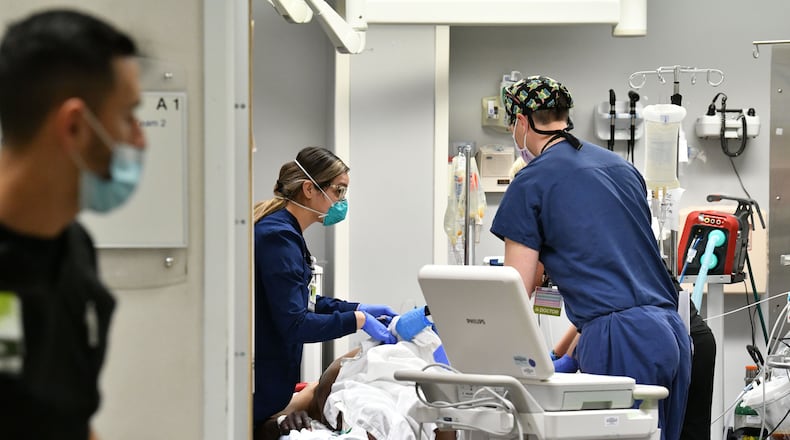In the months before the pandemic, Northside Hospital Inc. was looking to a prosperous future.
The Atlanta-based nonprofit and its subsidiaries ended their 2019 fiscal year with $350 million in cash, auditors reported. Revenues topped expenses by more than $532 million. Expansion plans were underway for Northside facilities in Forsyth, Cherokee and Gwinnett.
Then, when the pandemic hit, the federal government stepped in, sending Northside and its affiliates $195 million in provider relief funds.
The money, granted under the Coronavirus Aid Relief and Economic Security (CARES) Act, was designed to make up for revenues health care providers lost due to COVID-19 and to help pay for COVID-related expenses.
Yet critics say awards to well-financed facilities violate the spirit of a program designed to help struggling providers avoid financial ruin. For too many, the federal aid hasn’t been enough to stave off sharp losses. “It’s embarrassing because it’s not based on need and therefore doesn’t make a lot of sense,’' said Dr. Robert Berenson, a physician and a fellow at the Urban Institute, a Washington D.C-based economic think tank.
Now, as health care providers vie for the estimated $25.9 billion remaining in provider relief funds, fears are rising that facilities with low cash reserves but continued pressure from critically ill patients will be overlooked.
Credit: Jason Getz / AJC
Credit: Jason Getz / AJC
The government has made little effort to collect data to evaluate need or to require providers to demonstrate that COVID-19 has been the major reason for revenue loss and increased expenses, critics say.
Their plea: Shift more federal relief to those that were disadvantaged under early distribution methods and reduce the bureaucracy for accessing the funds.
“It shouldn’t go to those who got overpaid,” Berenson said.
Advocates for the move include smaller hospitals that saw virus cases peak later in the year and providers that take in less revenue because they treat large numbers of uninsured and underinsured patients.
They also include some pediatric offices that are struggling to stay afloat, said Dr. Sara “Sally” H. Goza, a Fayetteville pediatrician and immediate-past president of the American Academy of Pediatrics.
Many haven’t received enough relief funding to make up for declines of 20 to 30 percent in patient utilization rates, Goza said.
“Our pediatricians are still hurting a year later, and they need immediate financial relief,” she said.
Several healthcare providers contacted by the Atlanta Journal-Constitution described the federal funding as a lifeline to their financial stability and ability to continue provide care to patients.
Even with the relief money, some had to lay off staff or take other measures to reduce expenses.
Credit: ALYSSA.POINTER@AJC.COM
Credit: ALYSSA.POINTER@AJC.COM
Northeast Georgia Medical Center and Wellstar Health System told the AJC they had reduced executive compensation, as well as delayed or reduced capital expansion projects, among other cost-cutting measures.
At points of the pandemic, both systems had hospitals that stretched beyond capacity with COVID patients. NGMC, which has four hospital campuses, has received about $77 million in federal relief funds, federal data show. Marietta-based Wellstar, one of Georgia’s largest healthcare systems with 11 hospitals, received about $241 million, according to the data.
Northside VP Lee Echols told the AJC that some of the federal funds its system received were “general” in nature as determined by the U.S. Department of Health and Human Services.
“Others were considered ‘targeted’ or ‘hot spot’ distributions and funding was tied to COVID-19 volumes,” he said.
Northside’s hospital in Gwinnett, which had “very high COVID capacity” over several months, fell into that category, he said.
The hospital said it responded to the pandemic with “stabilizing measures,” which included removal of external consultants, reduction of vendor spending and a redeployment of employees to areas of greatest need.
‘Haves’ versus ‘have nots’
Goza, the Lafayette pediatrician, was among a tiny group of her peers who received relief money early on.
Like those hospitals that serve Medicare patients, Goza saw the money appear without asking for it. But it was almost nothing because most of her patients are on Medicaid and didn’t qualify for the first round of funding. In total, she got $15 for her only patient on Medicare — a young kidney transplant recipient.
It played out similarly for providers that primarily serve low-income and uninsured patients, said Beth Feldpush, senior vice president of policy and advocacy for America’s Essential Hospitals, an organization of 300 safety-net facilities.
Because they had a low share of Medicare revenue, as well as less revenue overall, which represented the basis for the first rounds of federal relief money, her members barely got any funding, Feldpush said.
“Given the fact that our members were already in a much tighter financial situation, it was incredibly challenging for them at the time,” she said.
Credit: contributed
Credit: contributed
Meanwhile, the federal payments resulted in some hospitals reporting record profits, further widening the gap between the wealthy providers and those barely making it.
There were efforts by the federal government to try to even out the allotments.
The U.S. Department of Health and Human Services in late summer issued rules prohibiting providers from getting funds that would make them more profitable in 2020 than they were in 2019. That way, HHS said, money could be reserved for those that were struggling. But members of Congress and industry sources objected, saying providers should be able to apply for enough to cover all lost revenues, without limitation, and HHS revised the rules.
HHS did target some funds to doctors’ offices and safety net hospitals serving low-income patients.
“But it wasn’t enough,’' said Goza, the pediatrician.
Berenson, of the Urban Institute, is examining the economic impact of COVID-19 on 50 U.S. health systems, based on indicators such as cash on hand and investment income. Those are better indicators of a hospital’s financial strength, he said, than, say, profit margins.
His analysis, which will be published in coming months, will emphasize that losses for most hospitals during the pandemic were largely short-term and small, in comparison to their assets, reserves and investments, he said.
“Our pediatricians are still hurting a year later, and they need immediate financial relief."
John Minahan, an Atlanta CPA who specializes in advising healthcare systems, said it was disconcerting that money went to some hospitals that would have thrived without it.
“I would say use your own money first,’' Minahan said.
Barriers to access
After initial rounds of funds were largely distributed automatically, health care providers had to apply for subsequent rounds.
But the federal government kept delaying and changing guidance on the application requirements and how the money could be spent, while warning that funds would be clawed back from recipients who failed to comply.
That created confusion and panic, particularly among smaller providers.
As a result, some didn’t apply, thinking that funds accepted under one version of the guidance might have to be returned later under revised definitions.
Many doctors also learned that they did not qualify for funding in the third round if they had not applied for money in the second. So, “they just gave up,” Goza said. “A lot of people did not apply.”
Some were at a disadvantage in applying because they could not afford to hire experts who could decipher on their behalf the various streams of funding and the reporting required.
Those with CPAs on hand, like his Gainesville practice, were likely more successful, said Dr. Andrew Reisman, president of the Medical Association of Georgia.
He received some money in the second round, but after that, he said, the well was dry.
“That was your play right there. You couldn’t get anything else after,” Reisman said.
Most providers experienced some frustration, said Gary Burke, a partner at Ernst & Young, who has clients in Atlanta. “They are continually having to react to changes, regarding compliance and important requirements. ”
Karyn Schwartz, a senior fellow at Kaiser Family Foundation, based in Washington, D.C., said virtually all healthcare providers have now qualified for a general grant that amounted to at least 2 percent of their previous annual patient revenue.
But with billions left to be distributed, it’s obvious to critics like Berenson how the government should divvy it up.
“Those that need it and didn’t get their rightful share in the first allocation should get it,” he said.
About the Author
Keep Reading
The Latest
Featured





